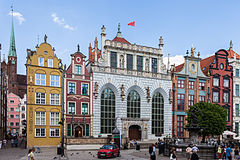Artushof
| Artus Court | |
|---|---|

The entrance to the Artus Court.
|
|
| General information | |
| Architectural style | Dutch mannerism |
| Town or city | Gdańsk |
| Country | Poland |
| Construction started | 1348 |
| Completed | 1350 |
| Design and construction | |
| Architect | Abraham van den Blocke (mannerist reconstruction, 1616-1617) |
The Artus Court, formerly also Junkerhof, (Polish: Dwór Artusa, German: Artushof) is a building in the centre of Gdańsk, Poland (German: Danzig), at Długi Targ 44, which used to be the meeting place of merchants and a centre of social life. Today it is a point of interest of numerous visitors and a branch of the Gdańsk History Museum.
The name was taken from the very popular medieval legend of King Arthur - a symbol of chivalry and gallantry. First in England, then in other European countries, his name was given to the houses where knights and aristocrats used to meet. In Poland Artus courts were founded and visited by bourgeoisie. There were several courts in Rzeczpospolita but the one in Gdańsk was by far the most famous. In the early 14th century Artus Courts existed in the Hanseatic towns of Elbing (Elbląg), Riga and Stralsund and similar courts like the House of the Blackheads at Riga and Tallinn. It was home to six fraternities which took their names from benches (Banken), the Reinhold's,St. Christopher's or Lübecker, Marienburger, Biblical Magi's, Counsillors' and the Dutch bench. These Confraternities were usually organized according to the merchant's or shipowner's trade relations, e.g. with Lübeck, the Netherlands or Poland and gathered the local elite - members of aristocracy and wealthy bourgeoisie. Already in 1492 merchants from England were allowed to appear at the Court. The entrance was banned for craftsmen, stall-keepers and hired workers. Wealthy merchants and visitors from abroad gathered here in the evenings. They paid for beverages in advance: 3 Schillings in the 17th century. Initially, at least in theory, talking about dealings was forbidden in the Court as the yard in front of it was designated for such purposes. Different performances took place in the evenings - musicians, singers, rope-dancers and jugglers came to amuse the visitors. Although they were officially banned, gambling, dice and card games as well as various bets were very popular. Normally only beverages and small snacks were served, but sometimes big feasts, which lasted even for a couple of days, were organized there. Especially at the end of the 17th century the feasts organized with great splendour began to turn into all-night drinking bouts. More and more complaints about the customs in the Court were made.
...
Wikipedia
